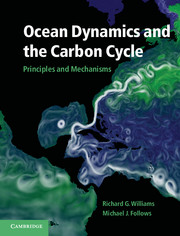Book contents
- Frontmatter
- Contents
- Preface
- Acknowledgements
- Illustration credits
- Part I Introduction
- Part II Fundamentals
- 3 Transport fundamentals
- 4 Physics fundamentals
- 5 Biological fundamentals
- 6 Carbonate chemistry fundamentals
- Part III Physical Phenomena and their Biogeochemical Signals
- Part IV Synthesis
- Appendix
- Symbols and definitions
- Glossary
- Answers
- References
- Index
- Plate section
3 - Transport fundamentals
from Part II - Fundamentals
Published online by Cambridge University Press: 05 June 2012
- Frontmatter
- Contents
- Preface
- Acknowledgements
- Illustration credits
- Part I Introduction
- Part II Fundamentals
- 3 Transport fundamentals
- 4 Physics fundamentals
- 5 Biological fundamentals
- 6 Carbonate chemistry fundamentals
- Part III Physical Phenomena and their Biogeochemical Signals
- Part IV Synthesis
- Appendix
- Symbols and definitions
- Glossary
- Answers
- References
- Index
- Plate section
Summary
The atmosphere and ocean are never at rest and continually move, whether it is the random walk of individual molecules or the grand meanders of the atmospheric Jet Stream. This movement transports fluid properties and tracers on all scales over the globe. You can see this transport in action whenever you watch a cloud passing aloft or water being swept along in a stream. Sometimes this transfer occurs in a simple manner, like the languid drift of a leaf down a calm river; other times it is more complicated, like waves sweeping a floating stick back and forth out at sea. The transfer becomes even more chaotic in a turbulent flow, as in how a rising smoke plume fragments into a series of turbulent eddies, and fluid follows apparently random paths.
The spreading of tracers can be understood in terms of how tracers are carried by the flow, diffused and eventually diluted. These processes apply equally to a dye spreading in a glass of spinning water, where narrow filaments of dye are initially drawn out before eventually being diluted, and tracers spreading over the ocean and atmosphere. For example, there are spiralling flows over the surface ocean suggesting active stirring, as illustrated in Fig. 3.1. This stirring then leads to tracers having patchy distributions, sometimes dragged out into filaments and sometimes forming coherent blobs or vortices.
In this chapter, we explain how tracers spread, describing how they are advected and diffused, and how to represent these processes more formally within a tracer budget.
- Type
- Chapter
- Information
- Ocean Dynamics and the Carbon CyclePrinciples and Mechanisms, pp. 43 - 65Publisher: Cambridge University PressPrint publication year: 2011



